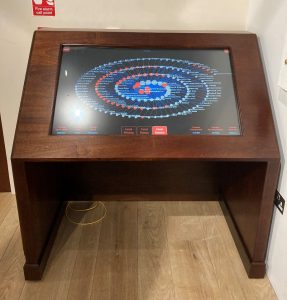
Brunel’s Networks – Interactive
Maria Pregnolato, Lecturer in Infrastructure Resilience, University of Bristol
James Boyd, Head of Research, Brunel Institute/SS Great Britain Trust
Christopher Woods, Head of Research Software Engineering, Advanced Computing Research Centre, University of Bristol
Brunel’s Networks – Interactive has created a physical real-world exhibit of the online network graphing project Brunel’s Networks. The project uses the archives of the Brunel Institute, a collaboration of the SS Great Britain Trust and University of Bristol, to digitally map the groups of individuals and working I.K. Brunel and major 19th century engineering innovations. This first project was developed as a web tool and was missing a physically interactive display. This JGI Seedcorn funding has provided the resources to create a physically interactive experience, which is now installed and in use at the SS Great Britain site (Figure 1).
By uploading the original code of the network graphing into a stable, non-networked (!) unit, the interactive experience can run continuously in a robust console, helping visitors to the SS Great Britain site understand the history of engineering through innovative data visualizations. The console was presented at the JGI showcase event in small table-top form in June 2022, and received positive feedback from visitors, public use. More feedback of the large-scale interactive exhibit will be evaluated during August, allowing the project researchers to understand how data visualisations help the public to understand the past, and the potential of STEM (e.g. programming) behind activities.
Public evaluations from Brunel’s Networks – Interactive will inform the ways in which the SS Great Britain Trust uses digital interactives and data visualizations in future exhibit use – a critical issue in developing contemporary visitor experience and public engagement. This interdisciplinary project combined historical research from the museum with research software engineering from the University, to improve the use of data visualisation in historical analysis, and to use data visualisation as an interpretive museum tool.

